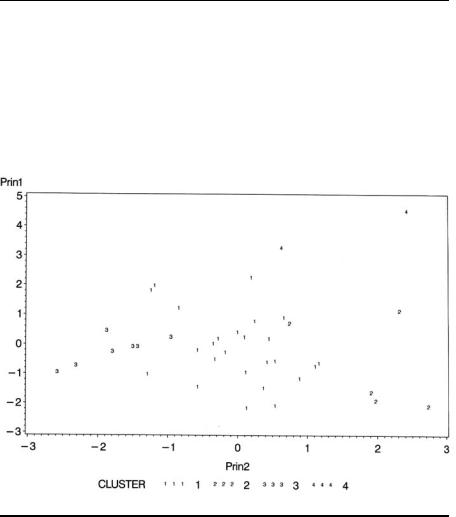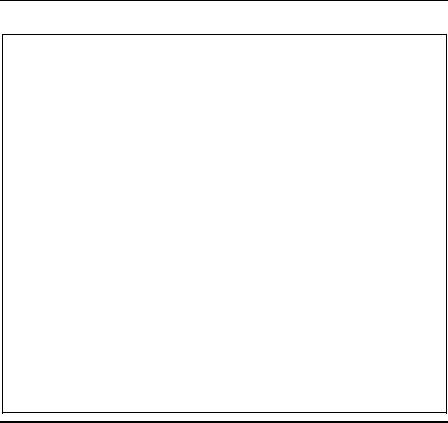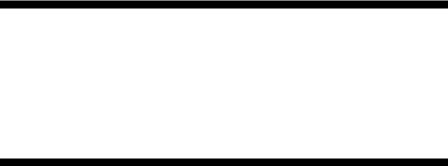
Handbook_of_statistical_analysis_using_SAS
.pdf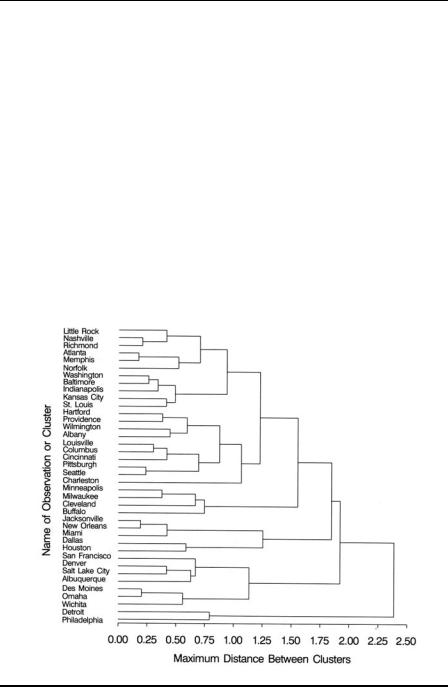
|
16 |
CL30 |
Cleveland |
3 |
0.0100 |
.902 . |
. |
0.6667 |
|
|
|
15 |
San Francisco |
CL17 |
4 |
0.0089 |
.893 . |
. |
0.6696 |
|
|
|
14 |
CL26 |
CL34 |
5 |
0.0130 .880 . |
. |
0.6935 |
|
||
|
13 |
CL27 |
CL21 |
6 |
0.0132 .867 . |
. |
0.7053 |
|
||
|
12 |
CL16 |
Buffalo |
4 |
0.0142 |
.853 . |
. |
0.7463 |
|
|
|
11 |
Detroit |
Philadelphia |
2 |
0.0142 |
.839 . |
. |
0.7914 |
|
|
|
10 |
CL18 |
CL14 |
9 |
0.0200 .819 . |
. |
0.8754 |
|
||
|
9 |
CL13 |
CL22 |
11 |
0.0354 .783 . |
. |
0.938 |
|
||
|
8 |
CL10 |
Charleston |
10 |
0.0198 |
.763 . |
. |
1.0649 |
|
|
|
7 |
CL15 |
CL20 |
7 |
0.0562 .707 .731 |
-1.1 |
1.134 |
|
||
|
6 |
CL9 |
CL8 |
21 |
0.0537 .653 .692 |
-1.6 |
1.2268 |
|
||
|
5 |
CL24 |
CL19 |
5 |
0.0574 .596 .644 |
-1.9 |
1.2532 |
|
||
|
4 |
CL6 |
CL12 |
25 |
0.1199 .476 |
.580 |
-3.2 |
1.5542 |
|
|
|
3 |
CL4 |
CL5 |
30 |
0.1296 .347 |
.471 |
-3.2 |
1.8471 |
|
|
|
2 |
CL3 |
CL7 |
37 |
0.1722 .174 |
.296 |
-3.0 |
1.9209 |
|
|
|
1 |
CL2 |
CL11 |
39 |
0.1744 .000 |
.000 |
0.00 |
2.3861 |
|
|
|
|
|
|
|
|
|
|
|
|
|
|
|
|
|
|
|
|
|
|
|
|
Display 14.5
Display 14.6
We see in Display 14.5 that complete linkage clustering begins with the same initial “fusions” of pairs of cities as single linkage, but eventually
©2002 CRC Press LLC

begins to join different sets of observations. The corresponding dendrogram in Display 14.6 shows a little more structure, although the number of groups is difficult to assess both from the dendrogram and using the CCC criterion.
The CLUSTER Procedure
Average Linkage Cluster Analysis
Eigenvalues of the Correlation Matrix
|
Eigenvalue |
Difference |
Proportion |
Cumulative |
1 |
2.09248727 |
0.45164599 |
0.3487 |
0.3487 |
2 |
1.64084127 |
0.36576347 |
0.2735 |
0.6222 |
3 |
1.27507780 |
0.48191759 |
0.2125 |
0.8347 |
4 |
0.79316021 |
0.67485359 |
0.1322 |
0.9669 |
5 |
0.11830662 |
0.03817979 |
0.0197 |
0.9866 |
6 |
0.08012683 |
|
0.0134 |
1.0000 |
The data have been standardized to mean 0 and variance 1 Root-Mean-Square Total-Sample Standard Deviation = 1
Root-Mean-Square Distance Between Observations = 3.464102
|
|
Cluster History |
|
|
|
|
||
|
|
|
|
|
|
|
Norm T |
|
|
|
|
|
|
|
|
RMS |
i |
NCL ----------Clusters Joined---------- FREQ SPRSQ RSQ ERSQ |
CCC |
Dist |
e |
|||||
38 |
Atlanta |
Memphis |
2 |
0.0007 |
.999 . |
. |
0.1588 |
|
37 |
Jacksonville |
New Orleans |
2 |
0.0008 |
.998 . |
. |
0.1783 |
|
36 |
Des Moines |
Omaha |
2 |
0.0009 |
.998 . |
. |
0.188 |
|
35 |
Nashville |
Richmond |
2 |
0.0009 |
.997 . |
. |
0.1897 |
|
34 |
Pittsburgh |
Seattle |
2 |
0.0013 |
.995 . |
. |
0.2193 |
|
33 |
Washington |
Baltimore |
2 |
0.0015 |
.994 . |
. |
0.2395 |
|
32 |
Louisville |
CL35 |
3 |
0.0023 |
.992 . |
. |
0.2721 |
|
31 |
CL33 |
Indianapolis |
3 |
0.0024 |
.989 . |
. |
0.2899 |
|
30 |
Columbus |
CL34 |
3 |
0.0037 |
.985 . |
. |
0.342 |
|
29 |
Minneapolis |
Milwaukee |
2 |
0.0032 |
.982 . |
. |
0.3508 |
|
28 |
Hartford |
Providence |
2 |
0.0033 |
.979 . |
. |
0.3523 |
|
27 |
CL31 |
Kansas City |
4 |
0.0041 |
.975 . |
. |
0.3607 |
|
26 |
CL27 |
St. Louis |
5 |
0.0042 |
.971 . |
. |
0.3733 |
|
25 |
CL32 |
Cincinnati |
4 |
0.0050 |
.965 . |
. |
0.3849 |
|
24 |
CL37 |
Miami |
3 |
0.0050 |
.961 . |
. |
0.3862 |
|
23 |
Denver |
Salt Lake City |
2 |
0.0040 |
.957 . |
. |
0.3894 |
|
22 |
Wilmington |
Albany |
2 |
0.0045 |
.952 . |
. |
0.4124 |
|
21 |
CL38 |
Norfolk |
3 |
0.0073 |
.945 . |
. |
0.463 |
|
20 |
CL28 |
CL22 |
4 |
0.0077 |
.937 . |
. |
0.4682 |
|
19 |
CL36 |
Wichita |
3 |
0.0086 |
.929 . |
. |
0.5032 |
|
18 |
Little Rock |
CL21 |
4 |
0.0082 |
.920 . |
. |
0.5075 |
|
©2002 CRC Press LLC

|
17 |
San Francisco |
CL23 |
3 |
0.0083 .912 . |
. |
0.5228 |
|
||
|
16 |
CL20 |
CL30 |
7 |
0.0166 .896 . |
. |
0.5368 |
|
||
|
15 |
Dallas |
Houston |
2 |
0.0078 .888 . |
. |
0.5446 |
|
||
|
14 |
CL18 |
CL25 |
8 |
0.0200 .868 . |
. |
0.5529 |
|
||
|
13 |
CL29 |
Cleveland |
3 |
0.0100 .858 . |
. |
0.5608 |
|
||
|
12 |
CL17 |
Albuquerque |
4 |
0.0097 .848 . |
. |
0.5675 |
|
||
|
11 |
CL14 |
CL26 |
13 |
0.0347 .813 . |
. |
0.6055 |
|
||
|
10 |
CL11 |
CL16 |
20 |
0.0476 .766 . |
. |
0.6578 |
|
||
|
9 |
CL13 |
Buffalo |
4 |
0.0142 .752 . |
. |
0.6666 |
|
||
|
8 |
Detroit |
Philadelphia |
2 |
0.0142 .737 . |
. |
0.7355 |
|
||
|
7 |
CL10 |
Charleston |
21 |
0.0277 .710 .731 |
-.97 |
0.8482 |
|
||
|
6 |
CL12 |
CL19 |
7 |
0.0562 .653 .692 |
-1.6 |
0.8873 |
|
||
|
5 |
CL7 |
CL24 |
24 |
0.0848 .569 .644 |
-2.9 |
0.9135 |
|
||
|
4 |
CL5 |
CL6 |
31 |
0.1810 |
.388 |
.580 |
-5.5 |
1.0514 |
|
|
3 |
CL4 |
CL9 |
35 |
0.1359 |
.252 |
.471 |
-5.3 |
1.0973 |
|
|
2 |
CL3 |
CL15 |
37 |
0.0774 |
.174 |
.296 |
-3.0 |
1.1161 |
|
|
1 |
CL2 |
CL8 |
39 |
0.1744 |
.000 |
.000 |
0.00 |
1.5159 |
|
|
|
|
|
|
|
|
|
|
|
|
|
|
|
|
|
|
|
|
|
|
|
Display 14.7
The average linkage results in Display 14.7 are more similar to those of complete linkage than single linkage; and again, the dendrogram (Display 14.8) suggests more evidence of structure, without making the optimal number of groups obvious.
It is often useful to display the solutions given by a clustering technique by plotting the data in the space of the first two or three principal components and labeling the points by the cluster to which they have been assigned. The number of groups that we should use for these data is not clear from the previous analyses; but to illustrate, we will show the four-group solution obtained from complete linkage.
proc tree data=complete out=clusters n=4 noprint; copy city so2 temperature--rainydays;
run;
As well as producing a dendrogram, proc tree can also be used to create a data set containing a variable, cluster, that indicates to which of a specified number of clusters each observation belongs. The number of clusters is specified with the n= option. The copy statement transfers the named variables to this data set.
The mean vectors of the four groups are also useful in interpretation. These are obtained as follows and the output shown in Display 14.9.
©2002 CRC Press LLC
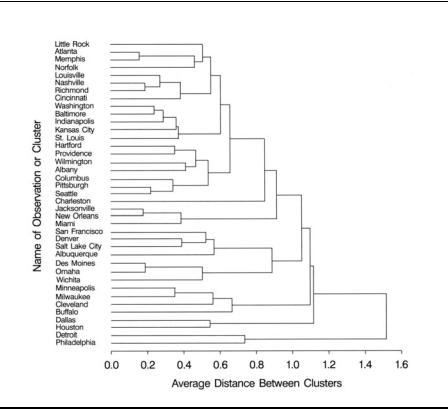
Display 14.8
proc sort data=clusters; by cluster;
proc means data=clusters; |
|
|
|
|
|
|
|
||||
|
var temperature-- |
rainydays; |
|
|
|
|
|
|
|||
|
by cluster; |
|
|
|
|
|
|
|
|
|
|
run; |
|
|
|
|
|
|
|
|
|
|
|
----------------------------------------- |
|
|
|
CLUSTER=1 ------------------------------------------ |
|
|
|
|
|
||
|
|
|
|
The MEANS Procedure |
|
|
|
|
|||
|
Variable |
N |
|
Mean |
|
Std Dev |
|
Minimum |
|
Maximum |
|
|
|
|
|
|
|
|
|
|
|
|
|
|
temperature |
25 |
53 |
.6040000 |
5 |
.0301160 |
43 |
.5000000 |
61 |
.6000000 |
|
|
factories |
25 |
370 |
.6000000 233.7716122 |
35 |
.0000000 |
|
1007.00 |
|
||
|
population |
25 |
470 |
.4400000 243.8555037 |
71 |
.0000000 |
905 |
.0000000 |
|
||
|
windspeed |
25 |
9 |
.3240000 |
1 |
.3690873 |
6 |
.5000000 |
12 |
.4000000 |
|
|
rain |
25 |
39 |
.6728000 |
5 |
.6775101 |
25 |
.9400000 |
49 |
.1000000 |
|
|
rainydays |
25 |
125 |
.8800000 |
18 |
.7401530 |
99 |
.0000000 |
166 |
.0000000 |
|
|
|
|
|
|
|
|
|
|
|
|
|
|
|
|
|
|
|
|
|
|
|
|
|
©2002 CRC Press LLC

----------------------------------------- |
|
|
|
|
-------------------------------------------CLUSTER=2 |
|
|
|
|
||
|
|
Variable |
N |
|
Mean |
|
Std Dev |
|
Minimum |
Maximum |
|
|
|
|
|
|
|
|
|
|
|
||
|
|
temperature |
5 |
69 |
.4600000 |
3.5317135 |
66 |
.2000000 75.5000000 |
|
||
|
|
factories |
5 |
381 |
.8000000 276.0556103 136.0000000 721.0000000 |
|
|||||
|
|
population |
5 |
660 |
.4000000 378.9364063 |
335 |
.0000000 |
1233.00 |
|
||
|
|
windspeed |
5 |
9 |
.5800000 |
1.1798305 |
8 |
.4000000 10.9000000 |
|
||
|
|
rain |
5 |
51 |
.0340000 |
9.4534084 |
35 |
.9400000 59.8000000 |
|
||
|
|
rainydays |
5 |
107 |
.6000000 18.7962762 |
78 |
.0000000 |
128.0000000 |
|
||
|
|
|
|
|
|
|
|
|
|
|
|
------------------------------------------ |
|
|
|
|
|
CLUSTER=3 ------------------------------------------ |
|
|
|
|
|
|
|
Variable |
N |
|
Mean |
|
Std Dev |
|
Minimum |
Maximum |
|
|
|
|
|
|
|
|
|
|
|
|
|
|
|
temperature |
7 |
53 |
.3571429 |
3 |
.2572264 |
49 |
.0000000 56.8000000 |
|
|
|
|
factories |
7 |
214 |
.2857143 168.3168780 |
46 |
.0000000 454.0000000 |
|
|||
|
|
population |
7 |
353 |
.7142857 195.8466358 176.0000000 716.0000000 |
|
|||||
|
|
windspeed |
7 |
10 |
.0142857 |
1 |
.5879007 |
8 |
.7000000 |
12.7000000 |
|
|
|
rain |
7 |
21 |
.1657143 |
9 |
.5465436 |
7 |
.7700000 30.8500000 |
|
|
|
|
rainydays |
7 |
83 |
.2857143 16.0801564 |
58 |
.0000000 |
103.0000000 |
|
||
|
|
|
|
|
|
|
|
|
|
||
----------------------------------------- |
|
|
|
|
CLUSTER=4 ------------------------------------------- |
|
|
|
|
||
|
|
Variable |
N |
|
Mean |
|
Std Dev |
|
Minimum |
Maximum |
|
|
|
|
|
|
|
|
|
|
|
||
|
|
temperature |
2 |
52 |
.2500000 |
3.3234019 |
49 |
.9000000 54.6000000 |
|
||
|
|
factories |
2 |
|
1378.00 444.0630586 |
|
1064.00 |
1692.00 |
|
||
|
|
population |
2 |
|
1731.50 309.0056634 |
|
1513.00 |
1950.00 |
|
||
|
|
windspeed |
2 |
9 |
.8500000 |
0.3535534 |
9 |
.6000000 10.1000000 |
|
||
|
|
rain |
2 |
35 |
.4450000 |
6.3427478 |
30 |
.9600000 39.9300000 |
|
||
|
|
rainydays |
2 |
122 |
.0000000 |
9.8994949 |
115 |
.0000000 |
129.0000000 |
|
|
|
|
|
|
|
|
|
|
|
|
|
|
|
|
|
|
|
|
|
|
|
|
|
|
|
|
|
|
|
|
|
|
|
|
|
|
Display 14.9
A plot of the first two principal components showing cluster membership can be produced as follows. The result is shown in Display 14.10.
proc princomp data=clusters n=2 out=pcout noprint; var temperature--rainydays;
©2002 CRC Press LLC
